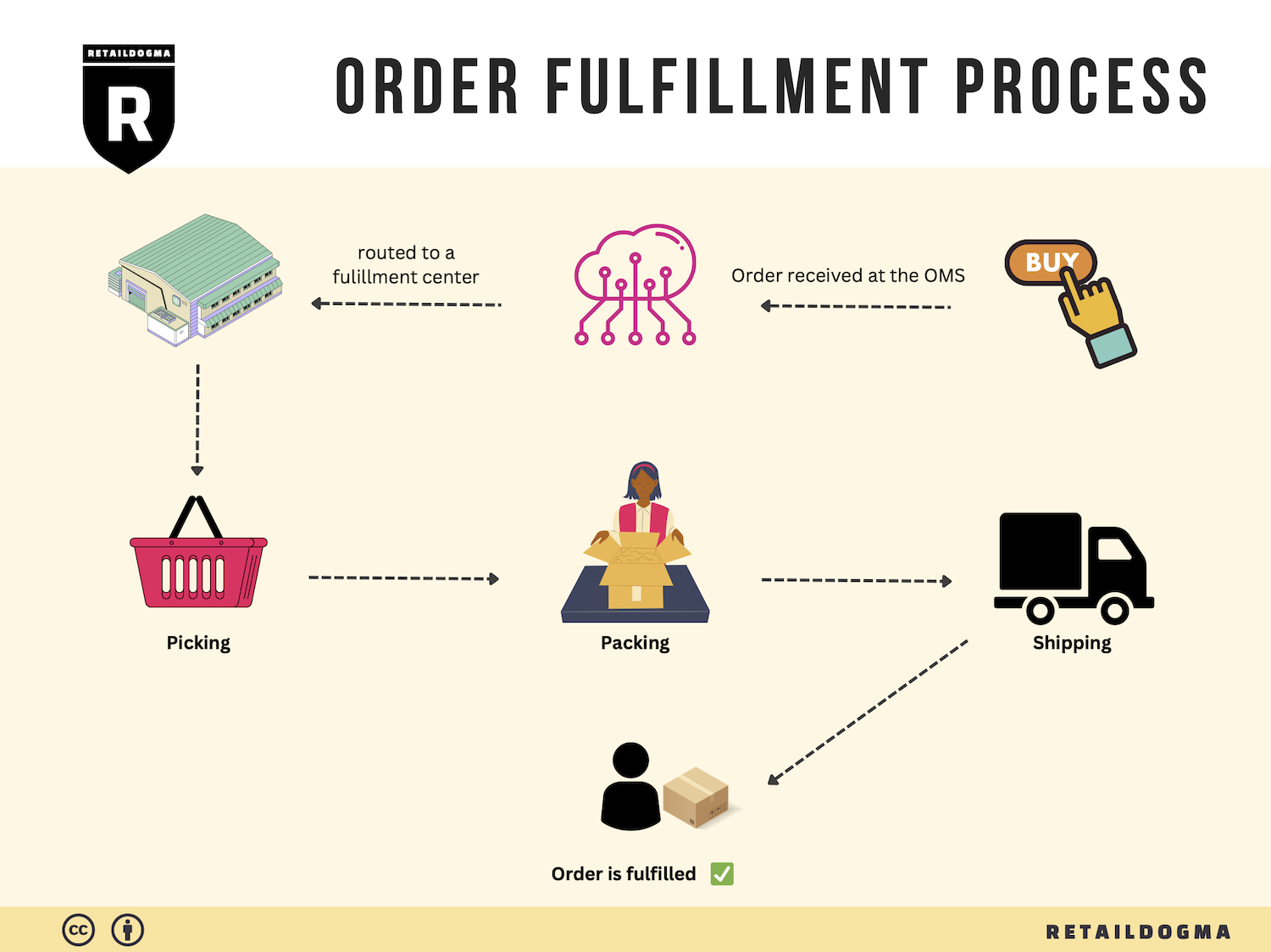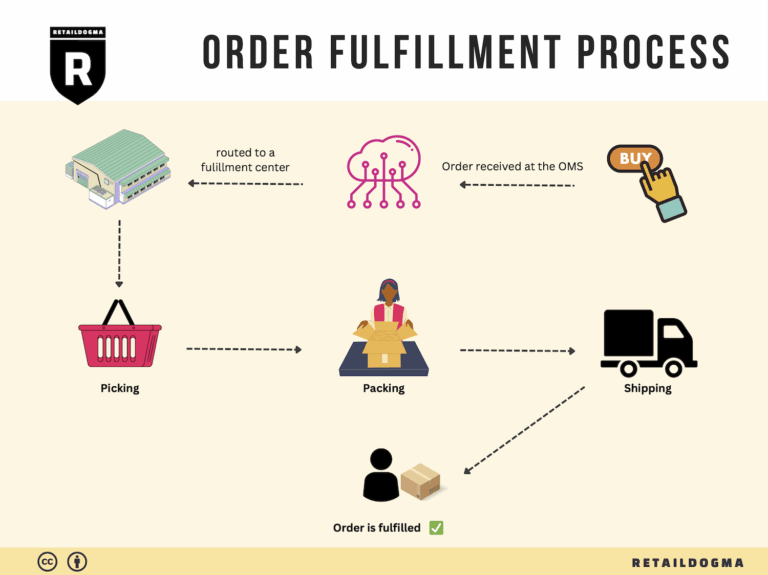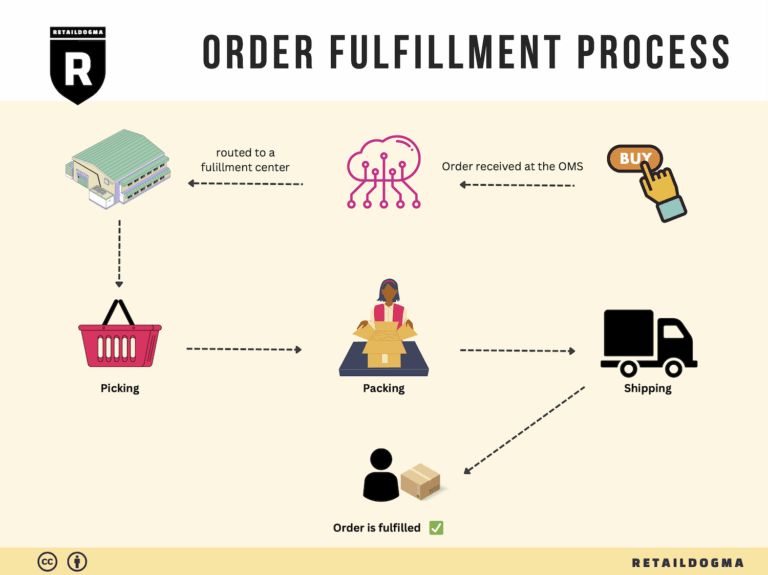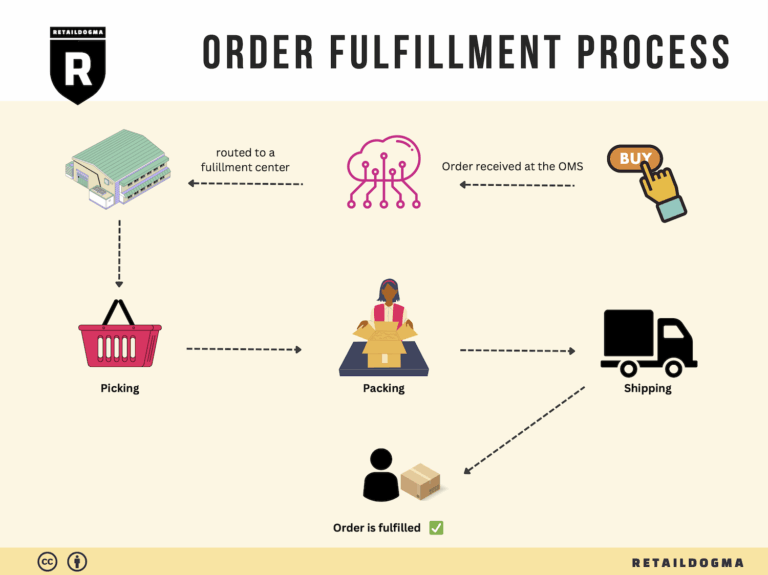How Order Fulfillment Works: A Step-by-Step Guide for Businesses
What is E-commerce Fulfillment? An Introduction for Growing Businesses
Understanding E-commerce Fulfillment for Growing Businesses
As an e-commerce business owner, the excitement of scaling your sales can often be overshadowed by the logistical challenges that come with it. One common pain point many entrepreneurs face is the overwhelming task of packing and shipping orders. Managing inventory, ensuring timely deliveries, and maintaining customer satisfaction can quickly become a daunting responsibility, especially as order volumes increase. This is where effective e-commerce fulfillment comes into play.
Fulfillment, in its simplest terms, refers to the entire process of getting a product into the hands of a customer. This encompasses everything from receiving inventory and managing stock levels to picking, packing, and shipping orders. For growing businesses, mastering this process is crucial for maintaining operational efficiency and enhancing customer experience.
In this guide, we will delve into the essential aspects of e-commerce fulfillment, providing you with the knowledge needed to navigate this complex landscape. We will explore different fulfillment models, including Third-Party Logistics (3PL) and Fulfillment by Amazon (FBA), highlighting their advantages and disadvantages. Understanding these options will help you determine which model aligns best with your business goals.
Additionally, we will discuss the core services involved in fulfillment, such as inventory management, order processing, and shipping logistics. Knowing what services are available will empower you to make informed decisions about your operational needs.
Choosing the right fulfillment partner is another critical component we will cover. The right partner can make or break your logistics strategy, so we will provide you with practical criteria to evaluate potential partners, ensuring they meet your unique requirements.
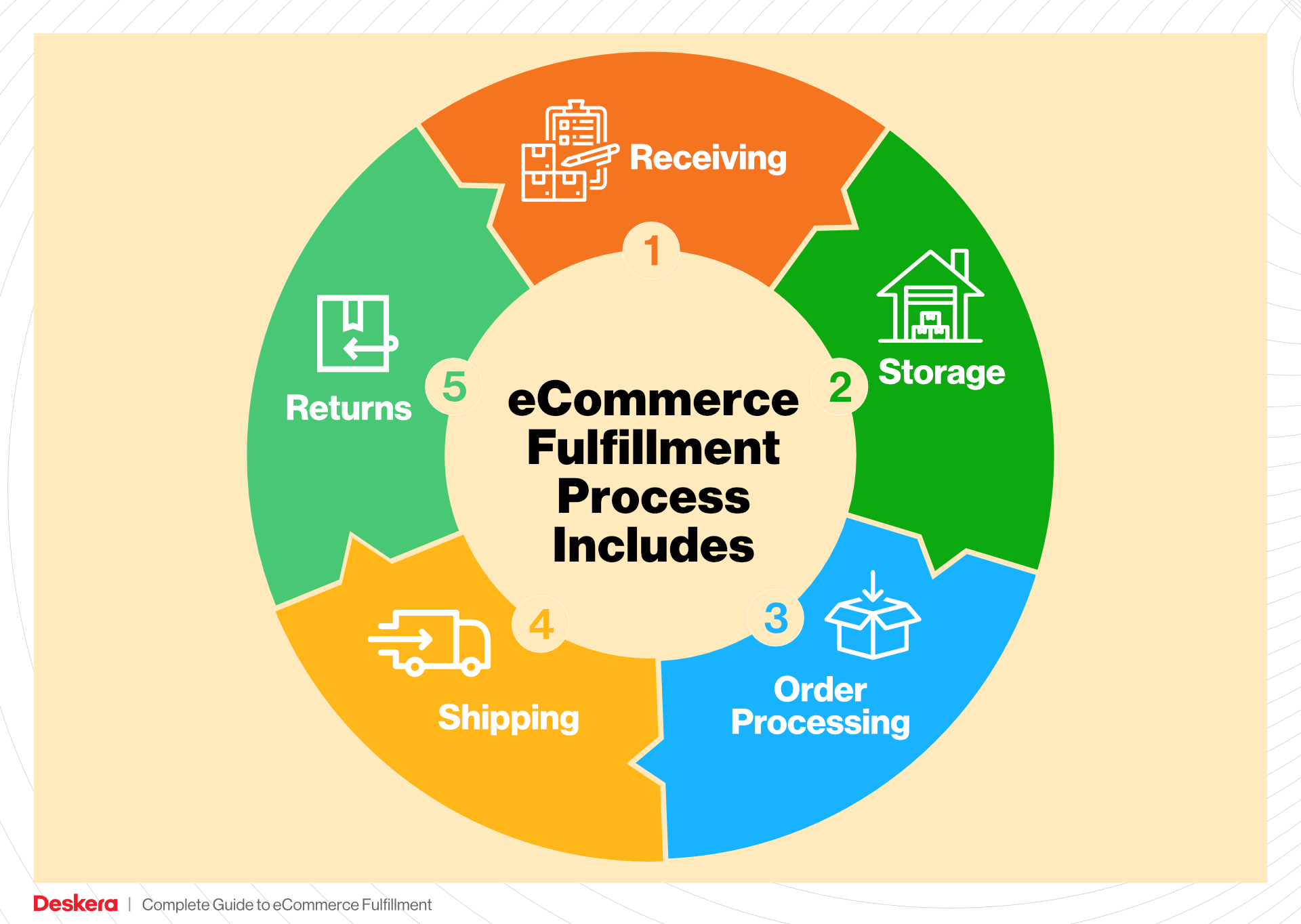
Finally, we will address pricing structures associated with various fulfillment services, helping you to budget effectively and avoid unexpected costs. Transparent pricing is vital for scaling your business sustainably.
The ultimate goal of this guide is to empower you to make smart, strategic decisions about your logistics. By understanding the nuances of e-commerce fulfillment, you can streamline your operations, enhance customer satisfaction, and focus on what truly matters—growing your business.
What You’ll Learn In This Guide
- What is E-commerce Fulfillment? An Introduction for Growing Businesses
- The Order Fulfillment Process: From ‘Buy’ Button to Customer’s Door
- Comparing Fulfillment Models: In-House vs. 3PL vs. Dropshipping
- A Deep Dive into Amazon FBA: Pros, Cons, and Who It’s For
- Core Services Offered by Fulfillment Centers
- How to Choose a Fulfillment Partner: A 6-Point Checklist
- Understanding Fulfillment Pricing: A Breakdown of Common Fees
- Frequently Asked Questions (FAQs) about Fulfillment
- Conclusion: Is Outsourcing Fulfillment the Right Move for Your Business?
- Important Disclaimer
The Order Fulfillment Process: From ‘Buy’ Button to Customer’s Door
1. Receiving Inventory
The first step in the order fulfillment process is receiving inventory. This involves the acceptance of goods from suppliers or manufacturers, which are then recorded into the inventory management system. During this step, each item is checked for quality and quantity against the purchase order. Key terms associated with this process include SKU (Stock Keeping Unit), which is a unique identifier for each product that helps in tracking and managing inventory efficiently.
This step is crucial because it ensures that the warehouse has the correct items on hand before they can be stored or picked for customer orders. Proper receiving practices help prevent inventory discrepancies, which can lead to stockouts or overstock situations. A well-organized receiving area and a streamlined process can significantly enhance the overall efficiency of the supply chain.
2. Warehouse Storage
Once inventory is received, it is stored in designated areas within the warehouse. This involves organizing products in a manner that maximizes space and allows for easy access. Proper warehouse storage techniques include using ABC analysis to categorize inventory based on turnover rates, ensuring that high-demand items are easily accessible.
Efficient warehouse storage is vital for minimizing retrieval times and optimizing space utilization. It also aids in maintaining an accurate inventory count, which is essential for effective order fulfillment. Utilizing technology such as warehouse management systems (WMS) can further enhance the storage process by automating tasks such as inventory tracking and location management.
3. Order Picking
The next step is order picking, where items are selected from the warehouse based on customer orders. This process often uses pick lists, which are documents or digital lists that outline the items and quantities needed for each order. Picking can be done in various ways, including single order picking, batch picking, or zone picking, depending on the volume and nature of the orders.
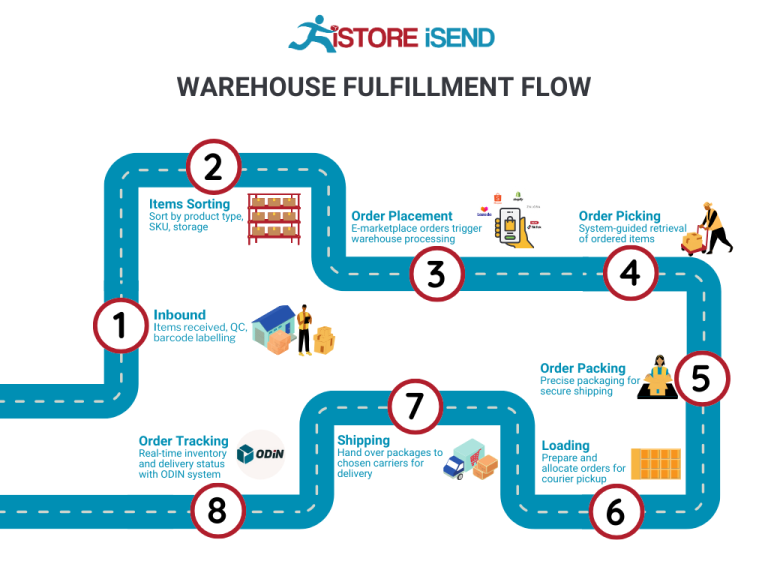
Order picking is critical as it directly impacts order accuracy and fulfillment speed. Errors at this stage can lead to customer dissatisfaction, returns, and increased operational costs. Implementing technology such as barcode scanners or RFID systems can streamline the picking process, reduce errors, and enhance overall efficiency.
4. Order Packing
After items are picked, they move to the packing stage. Here, products are carefully packed into boxes or other shipping containers, ensuring that they are protected during transit. This step involves verifying that the correct items are packed according to the pick list and may include the use of packing slips and shipping labels.
Packing is essential because it plays a significant role in the customer experience. Properly packed orders reduce the risk of damage during shipping and ensure that customers receive exactly what they ordered. Additionally, using sustainable packing materials can enhance a brand’s reputation and appeal to environmentally conscious consumers.
5. Shipping & Delivery
The final step in the order fulfillment process is shipping and delivery. Once orders are packed, they are handed off to shipping carriers, who transport them to the customer’s address. This process involves selecting the appropriate shipping method based on factors such as cost, delivery speed, and customer preferences. Key terms here include last-mile delivery, which refers to the final leg of the shipping journey from the distribution center to the customer’s door.
Shipping and delivery are critical as they are the last touchpoints in the customer journey. Timely and accurate delivery can significantly influence customer satisfaction and loyalty. Businesses should invest in reliable shipping partners and consider offering tracking options for customers to monitor their orders. Additionally, gathering feedback on the delivery experience can provide valuable insights for future improvements.
In summary, the order fulfillment process is a multifaceted operation that requires attention to detail at every step. By understanding and optimizing each phase—from receiving inventory to final delivery—e-commerce businesses can enhance their efficiency, reduce costs, and ultimately improve customer satisfaction.

Comparing Fulfillment Models: In-House vs. 3PL vs. Dropshipping
Fulfillment Model Comparison
| Model | Who Handles Inventory | Best For (Business Stage) | Key Advantage | Key Disadvantage |
|---|---|---|---|---|
| In-House Fulfillment | Business owns and manages inventory | Established businesses with stable sales | Greater control over operations and customer experience | Higher overhead costs and complexity |
| Third-Party Logistics (3PL) | Third-party provider manages inventory | Growing businesses looking to scale | Cost-effective scalability and expertise | Less control over inventory and processes |
| Dropshipping | Supplier manages inventory | Startups and low-capital businesses | Low startup costs and risk | Lower profit margins and less control |
In-House Fulfillment
In-house fulfillment involves a business managing its own inventory and logistics operations. This model is typically best suited for established businesses with stable sales and a clear understanding of their operational needs. The key advantage of in-house fulfillment lies in the control it offers over inventory management, order processing, and customer experience. Businesses can tailor their processes to meet specific customer demands and implement quality assurance measures directly. However, this model also comes with significant drawbacks, including higher overhead costs associated with warehousing, staffing, and technology. As a company scales, the complexity of managing logistics in-house can become overwhelming, potentially diverting focus from core business activities.
Third-Party Logistics (3PL)
Third-party logistics (3PL) providers handle inventory and fulfillment on behalf of businesses. This model is ideal for growing companies that are looking to scale without incurring the substantial costs associated with in-house fulfillment. 3PL providers leverage their expertise in logistics, technology, and supply chain management, allowing businesses to focus on their core competencies. The key advantage of using a 3PL is the ability to scale operations efficiently while benefiting from the provider’s established network and resources. However, one of the significant disadvantages is the reduced control over inventory and fulfillment processes. Businesses may find themselves reliant on the 3PL’s capabilities and responsiveness, which can be a risk if the provider’s performance does not meet expectations.
Dropshipping
Dropshipping is a fulfillment model where the supplier manages inventory and ships products directly to customers on behalf of the retailer. This model is particularly attractive for startups and businesses with limited capital, as it requires minimal upfront investment in inventory. The primary advantage of dropshipping is the low financial risk; retailers do not need to purchase inventory until a sale is made, thus avoiding the costs associated with unsold stock. However, dropshipping also has significant drawbacks, including lower profit margins due to reliance on supplier pricing and limited control over product quality and shipping times. Retailers must ensure they partner with reliable suppliers to maintain customer satisfaction, which can be challenging in a highly competitive e-commerce landscape.
Conclusion
Selecting the right fulfillment model is crucial for the success and scalability of an e-commerce business. Each model—In-house fulfillment, Third-Party Logistics, and Dropshipping—has its unique benefits and challenges. Business owners must assess their current stage, operational capabilities, and long-term goals to choose the model that best aligns with their strategy. By understanding the implications of each fulfillment method, entrepreneurs can make informed decisions that enhance efficiency, customer satisfaction, and ultimately, profitability.
A Deep Dive into Amazon FBA: Pros, Cons, and Who It’s For
Understanding Fulfillment by Amazon (FBA)
Fulfillment by Amazon (FBA) is a service provided by Amazon that allows sellers to store their products in Amazon’s fulfillment centers. Amazon takes care of storage, packaging, shipping, and even customer service for these products. This service enables sellers to leverage Amazon’s vast logistics network and customer base, thus simplifying the e-commerce process significantly.
How FBA Works
-
Product Listing: Sellers create product listings on Amazon’s marketplace and enroll their products in the FBA program.
-
Shipping to Amazon: Sellers send their products to Amazon’s fulfillment centers. This can involve a single shipment or multiple shipments depending on the inventory size and product type.
-
Storage: Once received, Amazon takes charge of the inventory. Products are stored in their warehouses until they are sold.
-
Order Fulfillment: When a customer orders a product, Amazon handles the picking, packing, and shipping. They also manage returns and customer inquiries related to the order.
-
Customer Service: Amazon provides customer service for FBA orders, allowing sellers to focus on other aspects of their business.
-
Payment: After the sale, Amazon deducts its fees from the sale price and transfers the remaining amount to the seller.
Pros of Using FBA
1. Prime Eligibility
One of the most significant advantages of FBA is that products become eligible for Amazon Prime. This can lead to increased sales, as Prime members often prefer products that offer free and fast shipping.
2. Customer Trust
Amazon has built a reputation for reliability and customer service. By using FBA, sellers can leverage this trust, which can lead to higher conversion rates. Products fulfilled by Amazon are often viewed as more credible compared to those shipped directly by third-party sellers.
3. Multi-Channel Fulfillment
FBA is not limited to Amazon sales. Sellers can use Amazon’s fulfillment services for orders placed on their own websites or other platforms. This flexibility allows businesses to streamline their logistics while still offering customers a great experience.
4. Time Savings
By outsourcing fulfillment to Amazon, sellers can save time on storage, packing, and shipping, allowing them to focus on product development, marketing, and other critical business areas.
5. Scalability
FBA allows businesses to scale quickly without the need for significant investments in warehousing or logistics. As sales increase, sellers can simply send more inventory to Amazon.
Cons of Using FBA
1. High Fees
FBA comes with various fees, including storage fees, fulfillment fees, and additional charges for long-term storage. These costs can add up quickly and impact profit margins, especially for lower-priced items.
2. Strict Inventory Rules
Amazon has strict inventory management rules, including limitations on the amount of inventory sellers can send to fulfillment centers. This can create challenges for businesses that experience fluctuating demand.
3. Commingling Risks
When products are commingled, they are mixed with inventory from other sellers. This can lead to issues if a customer receives a damaged or defective item, as it may not be clear whose inventory it originated from. Additionally, this can complicate the return process.
4. Loss of Control
By outsourcing fulfillment, sellers lose some control over the shipping process and customer interactions. While Amazon provides customer service, sellers may not always be able to respond to customers as quickly or personally as they would like.
5. Dependency on Amazon
Relying heavily on FBA can create a dependency on Amazon’s platform. Changes to Amazon’s policies or algorithms can significantly impact a seller’s business, making it essential to have a diversified sales strategy.
Who is FBA Best For?
Fulfillment by Amazon is particularly well-suited for:
-
Small to Medium-Sized Businesses: Companies looking to scale quickly without investing heavily in logistics can benefit from FBA’s infrastructure and services.
-
Sellers with High Sales Volume: Businesses that anticipate high order volumes can leverage FBA to manage fulfillment efficiently.
-
E-commerce Entrepreneurs: New sellers who want to tap into Amazon’s vast customer base and take advantage of Prime eligibility may find FBA an attractive option.
-
Brands Seeking Trust: Businesses that want to enhance their credibility and reliability in the eyes of customers can benefit from Amazon’s trusted platform.
-
Multi-Channel Sellers: Companies that sell on multiple platforms can use FBA to streamline their logistics across various sales channels.
In conclusion, while Fulfillment by Amazon offers numerous advantages that can significantly ease the burden of logistics and customer service, it is essential for sellers to weigh these benefits against the potential downsides, particularly regarding fees and control. By understanding both sides of the equation, e-commerce businesses can make informed decisions about whether FBA is the right fit for their growth strategy.
Core Services Offered by Fulfillment Centers
Inventory Management & Warehousing
Fulfillment centers provide robust inventory management and warehousing services that are critical for e-commerce businesses. This service involves the systematic storage, tracking, and management of stock within the fulfillment center. Advanced inventory management systems are employed to monitor stock levels, track product movement, and manage reorder points effectively.
Benefits to E-commerce Businesses:
1. Real-Time Visibility: With sophisticated inventory tracking systems, businesses gain real-time visibility into their stock levels. This reduces the risk of stockouts or overstocking, which can tie up capital and lead to lost sales.
2. Space Optimization: Fulfillment centers are designed to maximize storage efficiency. By utilizing advanced shelving systems and storage techniques, they can accommodate a wide variety of products while minimizing space requirements.
3. Cost Efficiency: Outsourcing inventory management can significantly reduce overhead costs associated with maintaining a warehouse. Businesses can save on rent, utilities, and labor costs while benefiting from the fulfillment center’s economies of scale.
Pick and Pack Services
Pick and pack services are at the core of fulfillment operations, where items are selected (picked) from inventory and packaged (packed) for shipment. This process is tailored to the specific needs of each order, ensuring that the right products are prepared for delivery in a timely manner.
Benefits to E-commerce Businesses:
1. Speed and Accuracy: Fulfillment centers employ trained staff and automated systems to ensure that orders are picked quickly and accurately. This enhances customer satisfaction through timely deliveries and reduces the likelihood of returns due to incorrect orders.
2. Scalability: As e-commerce businesses grow, so do their order volumes. Fulfillment centers can easily scale operations to meet increased demand, ensuring that businesses can handle peak seasons without compromising service quality.
3. Custom Packaging Options: Many fulfillment centers offer customized packaging solutions that can enhance branding. This allows businesses to create a memorable unboxing experience for their customers, which can lead to repeat purchases.
Kitting and Assembly
Kitting and assembly services involve combining multiple products into a single package or preparing items for sale. This can include bundling products together, assembling components, or creating gift sets. Such services are especially beneficial for businesses that sell complex items or promotional bundles.
Benefits to E-commerce Businesses:
1. Streamlined Operations: By outsourcing kitting and assembly, businesses can streamline their operations and focus on core activities such as marketing and customer service. This allows for more efficient use of resources and time.
2. Enhanced Product Offerings: Kitting enables businesses to offer unique product combinations that can attract customers. For instance, a home improvement store can bundle tools and accessories together, creating a convenient purchasing option for customers.
3. Cost Savings: Fulfillment centers often have the expertise and equipment necessary to efficiently assemble kits at scale, which can be more cost-effective than handling these processes in-house. This can lead to reduced labor costs and increased profit margins.
Returns Management (Reverse Logistics)
Returns management, or reverse logistics, is a crucial service provided by fulfillment centers. This process involves handling the return of products from customers back to the inventory. Efficient returns management is essential for maintaining customer satisfaction and loyalty in the e-commerce space.
Benefits to E-commerce Businesses:
1. Customer Retention: A smooth and hassle-free returns process can significantly enhance customer satisfaction. Fulfillment centers can manage returns efficiently, ensuring that customers receive prompt refunds or exchanges, which encourages repeat business.
2. Data Insights: Fulfillment centers can provide valuable data on return trends, helping businesses identify issues with specific products. This information can guide product improvements, inventory decisions, and marketing strategies.
3. Cost Efficiency: Managing returns in-house can be resource-intensive and costly. By outsourcing this function, businesses can reduce operational costs and focus on growth initiatives while ensuring that returns are processed swiftly and accurately.
In summary, fulfillment centers offer a range of core services that can significantly enhance the operational efficiency of e-commerce businesses. By leveraging these services, businesses can optimize their inventory management, improve order accuracy, enhance product offerings, and streamline returns, ultimately driving growth and customer satisfaction.
How to Choose a Fulfillment Partner: A 6-Point Checklist
Location & Warehouse Network
Importance:
The location of your fulfillment partner’s warehouses can significantly impact shipping times and costs. A partner with strategically located warehouses can reduce transit times and shipping fees, enhancing customer satisfaction.
Questions to Ask:
1. Where are your warehouses located, and how does this align with our customer demographics?
2. Do you have a network of warehouses that can provide nationwide coverage?
3. What is your average shipping time to major metropolitan areas?
Technology & Integrations
Importance:
In today’s digital landscape, a fulfillment partner’s technology stack is crucial for seamless operations. Efficient technology can automate order processing, inventory management, and tracking, which ultimately saves time and reduces errors.
Questions to Ask:
1. What technology platforms do you use for order management and inventory tracking?
2. Can your systems integrate with our existing e-commerce platform (e.g., Shopify, WooCommerce)?
3. Do you provide real-time analytics and reporting capabilities?
Specializations (e.g., Cold Storage, Oversized Items)
Importance:
Different businesses have unique needs based on their product types. If your products require special handling—like cold storage for perishable goods or extra space for oversized items—partnering with a specialist can be crucial.
Questions to Ask:
1. Do you have experience handling products similar to ours (e.g., perishables, fragile items)?
2. What specific services do you offer for specialized products?
3. Can you accommodate seasonal fluctuations in inventory and demand?
Scalability & Capacity
Importance:
As your business grows, your fulfillment needs will evolve. A capable partner should be able to scale their operations to accommodate your growth without compromising service quality.
Questions to Ask:
1. How do you handle peak seasons or sudden spikes in order volume?
2. What is your current capacity, and how do you plan to expand it in the future?
3. Can you provide examples of how you’ve scaled operations for other clients?
Pricing and Contracts
Importance:
Understanding the cost structure and contract terms is essential for budgeting and financial planning. Transparent pricing can help you avoid hidden fees that could affect your bottom line.
Questions to Ask:
1. What is your pricing model (e.g., per order, per item, monthly fees)?
2. Are there any additional fees for services like storage, packaging, or returns?
3. What are the contract terms, and is there flexibility for renegotiation as our business evolves?
Customer Support & Reviews
Importance:
Strong customer support can make a significant difference when issues arise. A partner that prioritizes customer service can help you navigate challenges quickly and efficiently.
Questions to Ask:
1. What level of support do you provide (e.g., dedicated account manager, 24/7 support)?
2. Can you provide references or reviews from other businesses in our industry?
3. How do you handle disputes or issues that arise during the fulfillment process?
Conclusion
Choosing the right fulfillment partner is a critical decision that can influence your e-commerce business’s success. By following this checklist and asking the right questions, you can ensure that your chosen partner aligns with your operational needs and growth ambitions. Remember, a strong fulfillment partner is not just a vendor but a strategic ally in your business’s journey.
Understanding Fulfillment Pricing: A Breakdown of Common Fees
Initial Setup Fees
Initial setup fees are typically charged by fulfillment centers when you first begin using their services. These fees can include costs associated with onboarding, integration with your existing systems, and the configuration of your account. They may also cover the initial setup of inventory management systems and training for your staff on how to use the fulfillment platform effectively.
The calculation of initial setup fees varies by provider and can range from a flat fee to a percentage of your expected monthly volume. To minimize these costs, consider negotiating with the fulfillment provider, especially if you are committing to a long-term contract or a significant volume of shipments.
Receiving Fees
Receiving fees are charged when the fulfillment center accepts and processes your inventory. This fee covers the labor and equipment required to unload, inspect, and store your products. Receiving fees may vary depending on the complexity of the inventory being received, such as the type of products (e.g., hazardous materials, oversized items) and the volume of goods.
Most fulfillment centers calculate receiving fees based on the number of pallets or cartons received. Some providers may also charge additional fees for special handling or if your products require additional quality checks. To ensure you’re getting a fair rate, ask for a detailed breakdown of what the receiving fee covers and if there are any additional charges for specific types of inventory.
Storage Fees (per pallet/bin)
Storage fees are charged for the space your inventory occupies within the fulfillment center. These fees are generally calculated on a monthly basis and can be charged per pallet or per bin, depending on how your products are stored. The cost can vary significantly based on the location of the fulfillment center, as prime locations may charge higher rates due to increased demand.
To optimize storage fees, consider the following strategies:
– Inventory Management: Regularly review your inventory turnover rates and remove slow-moving items to reduce storage costs.
– Seasonal Adjustments: Plan for seasonal fluctuations in demand by adjusting your inventory levels accordingly to avoid overstocking.
Pick & Pack Fees (per item/order)
Pick and pack fees are incurred each time an order is fulfilled. This fee covers the labor involved in selecting items from inventory (picking) and preparing them for shipment (packing). Pick and pack fees can be charged per item or per order, with costs typically decreasing as order volumes increase.
The calculation of pick and pack fees varies based on several factors:
– Order Complexity: More complex orders that require multiple items or special packaging may incur higher fees.
– Volume Discounts: Many fulfillment centers offer tiered pricing, so higher order volumes can lead to reduced pick and pack fees.
To minimize pick and pack fees, consider consolidating orders when possible and standardizing your packaging requirements to streamline the process.
Shipping Fees
Shipping fees are one of the most significant costs in fulfillment, as they cover the transportation of goods from the fulfillment center to the customer. These fees can vary widely based on several factors, including the shipping method (e.g., ground, air), the weight and dimensions of the package, and the destination.
Shipping fees are usually calculated based on:
– Weight and Size: Heavier and larger packages typically incur higher shipping costs.
– Carrier Rates: Different carriers (e.g., UPS, FedEx, USPS) have varying rates, so it’s beneficial to compare options to find the most cost-effective solution.
To manage shipping fees effectively, consider negotiating rates with carriers or exploring fulfillment centers that offer discounted shipping through partnerships with logistics providers.
Tips for Getting an Accurate Quote
-
Define Your Needs: Clearly outline your expected order volume, types of products, and any special handling requirements. This information will help fulfillment centers provide more accurate quotes.
-
Request Detailed Breakdowns: Ask for detailed quotes that outline all potential fees, including setup, receiving, storage, pick and pack, and shipping. This transparency will help you compare different providers more effectively.
-
Negotiate Terms: Don’t hesitate to negotiate fees, especially if you anticipate a long-term partnership or high order volumes. Many fulfillment centers are open to discussing pricing structures.
-
Consider Long-Term Contracts: If you’re confident in your business’s growth trajectory, consider signing a longer-term contract. Many providers offer discounts for commitments, which can lead to significant savings.
-
Review Regularly: As your business grows and changes, periodically review your fulfillment needs and costs to ensure you’re still getting the best deal. Adjust your agreements as necessary to stay aligned with your business objectives.
By understanding these common fulfillment pricing models and taking proactive steps to manage costs, you can enhance your e-commerce operations and support your business’s growth effectively.
Frequently Asked Questions (FAQs) about Fulfillment
1. What is the role of a Lowe’s Fulfillment Associate?
A Lowe’s Fulfillment Associate is responsible for processing online orders, picking, packing, and shipping products accurately and efficiently. They ensure that inventory is managed correctly and assist in maintaining a clean and organized workspace within the fulfillment center.
2. How does Lowe’s fulfillment process work?
The fulfillment process at Lowe’s involves receiving online orders, locating the products in the warehouse, picking the items, packing them for shipment, and finally, shipping them to the customer. This process is designed to be efficient to ensure timely delivery and customer satisfaction.
3. What skills are required to be a successful Fulfillment Associate at Lowe’s?
Key skills for a Fulfillment Associate include attention to detail, strong organizational abilities, the capability to operate warehouse equipment (like forklifts), good communication skills, and a willingness to work as part of a team. Physical stamina is also important, as the job often involves lifting and moving products.
4. What is the difference between a warehouse and a fulfillment center?
A warehouse is primarily used for storage, where products are kept until they are needed. In contrast, a fulfillment center is designed specifically for processing orders and shipping them directly to customers. Fulfillment centers often include advanced technology to optimize order processing and inventory management.
5. What is a 3PL (Third-Party Logistics)?
A 3PL is a service provider that manages logistics and supply chain operations on behalf of another company. This can include warehousing, fulfillment, and shipping services. Businesses often use 3PLs to enhance their distribution capabilities without having to invest in their own infrastructure.
6. How much do fulfillment services cost?
Fulfillment service costs can vary widely depending on factors like the volume of orders, the complexity of the services offered, and the specific fulfillment center’s pricing structure. Generally, costs can include storage fees, picking and packing fees, shipping costs, and any additional services such as returns processing.
7. What benefits do Lowe’s Fulfillment Associates receive?
Lowe’s offers a variety of benefits to its Fulfillment Associates, including competitive pay, discretionary bonuses, 401(k) plans with company matching, paid time off, and access to tuition-free education and training programs. Associates may also receive discounts on merchandise.
8. How can I apply for a Fulfillment Associate position at Lowe’s?
To apply for a Fulfillment Associate position at Lowe’s, visit the Lowe’s Careers website and navigate to the Supply Chain or Fulfillment sections. Here, you can search for available positions, submit your application, and upload your resume.
9. What are the typical working hours for a Lowe’s Fulfillment Associate?
Working hours for a Fulfillment Associate can vary based on the needs of the fulfillment center. Many positions may require shifts that include nights, weekends, and holidays to ensure that orders are processed and shipped promptly.
10. How does Lowe’s ensure efficient order fulfillment?
Lowe’s employs various strategies to ensure efficient order fulfillment, including advanced inventory management systems, automated picking technologies, and well-organized warehouse layouts. Continuous training for associates and adopting best practices in logistics further enhance operational efficiency.
Conclusion: Is Outsourcing Fulfillment the Right Move for Your Business?
Evaluating the Benefits of Outsourcing Fulfillment
In today’s fast-paced e-commerce landscape, outsourcing fulfillment can be a strategic move for businesses looking to scale effectively. One of the most significant advantages is time savings. By partnering with a fulfillment service, you can redirect your focus from logistics and inventory management to core business functions such as marketing, product development, and customer engagement. This shift not only enhances productivity but also allows your team to concentrate on driving sales and improving customer experiences.
Scalability is another critical benefit. As your business grows, so do your fulfillment needs. A dedicated fulfillment partner can seamlessly scale operations to meet increasing demand without the need for extensive investments in infrastructure or workforce. This flexibility is essential for navigating seasonal fluctuations and unexpected spikes in order volume, ensuring that you can deliver on customer expectations consistently.
Moreover, fulfillment services bring a wealth of expertise to the table. These partners are specialized in logistics and have established systems in place that can enhance efficiency, reduce shipping costs, and improve delivery times. Their experience can also help you navigate complex challenges, such as compliance with shipping regulations or managing international logistics.
However, the success of outsourcing fulfillment hinges on choosing the right partner. It’s crucial to conduct thorough research and select a provider that aligns with your business goals and values. Look for partners that offer transparency, reliability, and a proven track record in your industry.
As a strategic next step, consider auditing your current shipping and fulfillment processes. Assess whether your existing system meets your business needs or if a fulfillment partner could unlock new growth opportunities. By taking this proactive approach, you can position your business for success in an increasingly competitive marketplace.
Important Disclaimer
⚠️ Important Disclaimer
The information in this guide is for educational purposes. Fulfillment services, pricing, and platform features change frequently. Always conduct your own due diligence and consult with providers directly before making business decisions.
